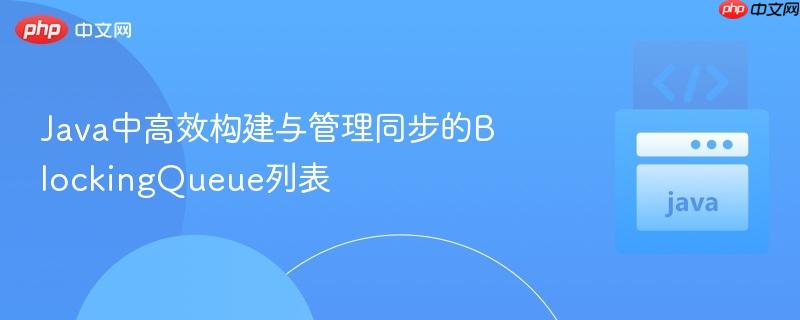
本文将深入探讨在Java中如何正确构建一个包含多个`BlockingQueue
在Java并发编程中,我们经常需要处理线程安全的数据结构。一个常见的需求是创建一个包含多个BlockingQueue实例的列表,并确保这个列表本身也是线程安全的。然而,在尝试初始化这样的数据结构时,开发者可能会遇到一些常见的误解。
许多开发者在初始化ArrayList时,可能会使用带容量参数的构造函数,例如 new ArrayList<>(15),并期望这会创建一个包含15个空元素的列表。但实际上,这个构造函数仅仅是为ArrayList的底层数组预分配了内存空间,以优化后续的元素添加操作,而不会改变列表的实际大小(size)。这意味着,new ArrayList<>(15)创建的列表其size()仍然是0,因为它不包含任何元素。
要构建一个包含特定数量BlockingQueue实例的列表,我们需要显式地向列表中添加这些队列对象。此外,BlockingQueue是一个接口,需要选择其具体实现,例如ArrayBlockingQueue。ArrayBlockingQueue在其构造函数中也需要指定一个容量,这代表了该队列能够存储的最大元素数量。
立即学习“Java免费学习笔记(深入)”;
接下来,我们将介绍两种有效的方法来构建一个同步的、预填充了BlockingQueue实例的列表。
Java 8引入的Stream API提供了一种声明式、函数式的方法来处理集合数据。结合Collectors.collectingAndThen,我们可以优雅地构建所需的同步列表。
import java.util.List;
import java.util.concurrent.ArrayBlockingQueue;
import java.util.concurrent.BlockingQueue;
import java.util.concurrent.atomic.AtomicInteger;
import java.util.Collections;
import java.util.stream.Collectors;
import java.util.stream.Stream;
public class SynchronizedBlockingQueueListGenerator {
public static void main(String[] args) {
final int queueCapacity = 10; // 每个BlockingQueue的容量
final int numberOfQueues = 5; // 列表中BlockingQueue的数量
// 使用Stream API生成并同步列表
List<BlockingQueue<AtomicInteger>> listOfQueues =
Stream.generate(() -> new ArrayBlockingQueue<AtomicInteger>(queueCapacity))
.limit(numberOfQueues)
.collect(Collectors.collectingAndThen(
Collectors.toList(),
Collections::synchronizedList
));
System.out.println("Stream API生成的列表大小: " + listOfQueues.size());
// 验证列表中的队列是否可操作
listOfQueues.forEach(queue -> {
System.out.println("队列容量: " + ((ArrayBlockingQueue<AtomicInteger>)queue).remainingCapacity());
try {
queue.put(new AtomicInteger(1));
} catch (InterruptedException e) {
Thread.currentThread().interrupt();
}
});
}
}代码解析:
对于不熟悉Stream API的开发者,或者在简单场景下,使用传统的for循环迭代添加元素也是一个清晰直观的选择。
import java.util.ArrayList;
import java.util.List;
import java.util.concurrent.ArrayBlockingQueue;
import java.util.concurrent.BlockingQueue;
import java.util.concurrent.atomic.AtomicInteger;
import java.util.Collections;
public class SynchronizedBlockingQueueListGeneratorTraditional {
public static void main(String[] args) {
final int queueCapacity = 10; // 每个BlockingQueue的容量
final int numberOfQueues = 5; // 列表中BlockingQueue的数量
// 使用for循环生成列表
List<ArrayBlockingQueue<AtomicInteger>> tempListOfQueues = new ArrayList<>();
for (int i = 0; i < numberOfQueues; i++) {
tempListOfQueues.add(new ArrayBlockingQueue<>(queueCapacity));
}
// 将生成的列表包装成同步列表
List<BlockingQueue<AtomicInteger>> synchronizedListOfQueues =
Collections.synchronizedList(tempListOfQueues);
System.out.println("for循环生成的列表大小: " + synchronizedListOfQueues.size());
// 验证列表中的队列是否可操作
synchronizedListOfQueues.forEach(queue -> {
System.out.println("队列容量: " + ((ArrayBlockingQueue<AtomicInteger>)queue).remainingCapacity());
try {
queue.put(new AtomicInteger(2));
} catch (InterruptedException e) {
Thread.currentThread().interrupt();
}
});
}
}代码解析:
正确构建一个包含多个BlockingQueue实例的同步列表,关键在于理解ArrayList的容量与大小的区别,并显式地填充列表。无论是采用现代的Stream API结合collectingAndThen的函数式方法,还是传统的for循环迭代方法,都能有效地实现这一目标。最终生成的同步列表将为并发应用程序提供一个稳定且线程安全的基础结构,但请务必记住Collections.synchronizedList的同步范围限制,并结合BlockingQueue自身的线程安全特性进行编程。
以上就是Java中高效构建与管理同步的BlockingQueue列表的详细内容,更多请关注php中文网其它相关文章!

每个人都需要一台速度更快、更稳定的 PC。随着时间的推移,垃圾文件、旧注册表数据和不必要的后台进程会占用资源并降低性能。幸运的是,许多工具可以让 Windows 保持平稳运行。

Copyright 2014-2025 https://www.php.cn/ All Rights Reserved | php.cn | 湘ICP备2023035733号